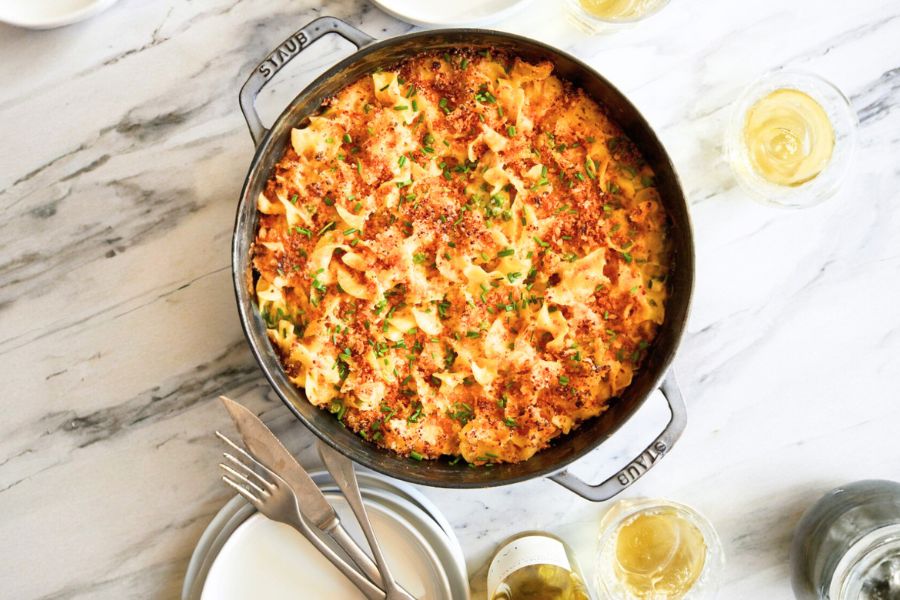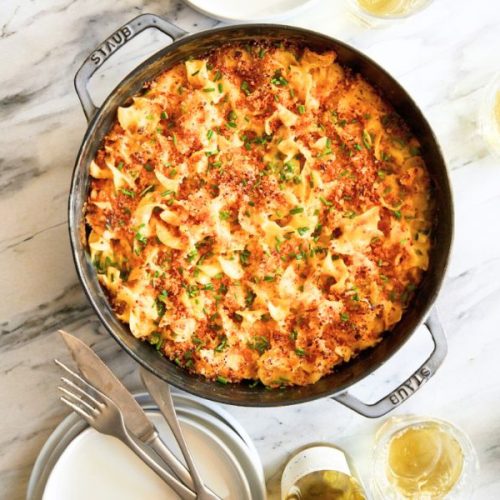This Tuna Noodle Casserole stands out for its comforting creaminess combined with a satisfying crunch from the Panko topping, making it a classic yet elevated weeknight meal.
Packed with protein from the canned tuna and sharp cheddar, it supports muscle health and keeps you full longer.
The inclusion of green peas adds fiber and essential vitamins, balancing the dish nutritionally.
Using half and half instead of heavy cream strikes a nice balance between indulgence and moderate saturated fat, while the garlic, shallots, and Dijon mustard bring bright, savory depth.

This recipe is a smart choice for everyday cooking because it’s quick to prepare, uses pantry staples, and bakes all in one Dutch oven—perfect for easy meal prep or cozy dinners with minimal cleanup.
Must-Have Tools for Perfect Results:
Mixing Bowl (small)
Perfect for combining the Panko topping ingredients evenly. Multipurpose and essential for prepping, marinating, or mixing any recipe components.
Dutch Oven
Ideal for sautéing aromatics and baking the casserole all in one pot, saving time and reducing dishes. Its even heat distribution ensures creamy sauces and perfectly cooked noodles. A versatile essential for soups, braises, and casseroles.
Large Pot
Used to boil egg noodles to the perfect al dente texture. A sturdy pot with a heavy bottom prevents sticking and boiling over—great for pasta, blanching, or making stocks.
Whisk
Crucial for smoothly incorporating flour into butter and preventing lumps in the sauce. A well-designed whisk ensures silky, creamy textures in sauces, gravies, and dressings.

Crunchy Tuna Noodle Casserole
Equipment
- 1 Dutch Oven
- 1 Large Pot
- 1 Whisk
- 1 Small Mixing Bowl
Ingredients
- 10 ounces wide egg noodles about 4 ½ cups
- 3 tablespoons unsalted butter
- 3 cloves garlic finely minced
- 2 large shallots finely diced
- 2 tablespoons all-purpose flour
- 3 ½ cups half-and-half cream
- 2 teaspoons Dijon mustard
- 8 ounces sharp white cheddar cheese shredded (about 2 cups)
- 3 cans 5 ounces each tuna packed in water, drained
- 1 cup frozen green peas thawed and rinsed
- Salt preferably kosher and freshly ground black pepper, to taste
- 2 tablespoons fresh chives chopped
For the crispy topping:
- ⅓ cup Panko breadcrumbs
- ⅓ cup freshly grated Parmesan cheese
- 1 tablespoon lemon zest
- 1 tablespoon olive oil
Instructions
- Cook the Noodles: Bring a large pot of salted water to a boil. Add the egg noodles and cook until just tender according to package directions, usually 7-9 minutes. Drain thoroughly and set aside.
- Prepare the Flavor Base: Preheat your oven to 400°F (200°C). In a large Dutch oven over medium heat, melt the butter. Add the minced garlic and diced shallots, cooking gently while stirring until they release a fragrant aroma and soften, about 2 minutes.
- Create the Sauce Roux: Sprinkle the flour over the softened shallots and garlic, stirring constantly to coat and cook the flour for about a minute, until it turns slightly golden.
- Build the Creamy Sauce: Slowly whisk in the half-and-half and the Dijon mustard, stirring frequently to avoid lumps. Let the mixture simmer gently until it thickens slightly, about 4-5 minutes.
- Add Cheese and Combine: Remove the Dutch oven from heat. Stir in the shredded cheddar until melted and smooth, creating a rich, creamy sauce.
- Mix in Main Ingredients: Fold the cooked noodles, drained tuna, and green peas into the cheese sauce. Season generously with salt and freshly ground black pepper to taste.
- Prepare the Crispy Topping: In a small bowl, combine Panko breadcrumbs, grated Parmesan, lemon zest, and olive oil. Mix well until the crumbs are evenly coated.
- Assemble and Bake: Sprinkle the Panko topping evenly over the casserole mixture in the Dutch oven. Transfer to the oven and bake until the topping is golden brown and the casserole is bubbling, about 25-30 minutes.
- Garnish and Serve: Remove from oven and let cool slightly. Garnish with fresh chopped chives before serving for a fresh, herbaceous finish.
Notes
- Noodle Tip: Use wide egg noodles or a similar pasta shape like rotini or shells for best texture. Avoid overcooking to prevent mushiness.
- Cheese Variation: Sharp white cheddar adds great flavor, but you can substitute with a mix of cheddar and Gruyère for a nutty twist.
- Make-Ahead: Assemble the casserole up to step 7, cover, and refrigerate for up to 24 hours before baking. Add 5 extra minutes to baking time if chilled.
- Tuna Choice: Use high-quality canned tuna packed in water to keep the casserole light and moist. Drain well to avoid sogginess.
- Extra Veggies: Feel free to add sautéed mushrooms or chopped spinach for additional nutrients and texture.
Chef’s Secrets for Creamy Texture
Achieving the perfect creamy texture in this tuna noodle casserole starts with the roux—the butter and flour mixture.
Cooking the flour just long enough to remove the raw taste, but not so long that it browns too much, is key for a silky sauce.
Slowly whisking in the half-and-half helps prevent lumps and ensures the sauce thickens evenly.
Using sharp white cheddar cheese adds a tangy depth, while stirring it in off the heat helps the cheese melt smoothly without becoming grainy.
For a bright contrast, the lemon zest in the Panko topping adds freshness and balances the richness.
Don’t skip rinsing frozen peas to avoid icy water diluting the sauce, and make sure to drain the tuna thoroughly to keep the casserole from getting watery.
Lastly, baking it in a Dutch oven or similarly heavy, oven-safe pot helps the casserole cook evenly and develop a beautifully crisp topping.
Serving Suggestions to Impress Guests
This classic casserole pairs wonderfully with simple, fresh side dishes that balance its richness.
A crisp green salad dressed with lemon vinaigrette or a light cucumber and tomato salad offers a refreshing counterpoint.
Roasted or steamed seasonal vegetables, like asparagus or green beans, add color and nutrients to the plate.
For a cozy, hearty meal, serve alongside warm crusty bread or garlic breadsticks to soak up the creamy sauce.
Garnishing with freshly chopped chives or a sprinkle of extra Parmesan just before serving enhances the visual appeal and flavor.
This dish is also perfect for potlucks and family dinners because it’s easy to portion and stays satisfying even when reheated.
Storage Tips for Freshness Longer
To keep this tuna noodle casserole fresh, allow it to cool completely before storing.
Transfer leftovers to an airtight container and refrigerate for up to 3-4 days.
When reheating, cover the dish loosely with foil or a microwave-safe lid to maintain moisture and prevent the topping from drying out.
Reheat gently in a 350°F (175°C) oven for 15-20 minutes or in short intervals in the microwave, stirring halfway through.
For longer storage, you can freeze the casserole before baking or after fully cooked. Wrap tightly in foil and plastic wrap, and freeze for up to 2 months.
Thaw overnight in the fridge before baking or reheating to preserve texture and flavor. Avoid freezing the Panko topping separately, as it may lose its crispness.
Frequently Asked Questions Answered Clearly
1. Can I use a different type of pasta?
Absolutely! While wide egg noodles are traditional, you can substitute with rotini, shells, or penne. Just adjust cooking times slightly to avoid overcooked pasta.
2. Is canned tuna the best choice?
Canned tuna packed in water works best for this recipe as it keeps the casserole moist and light. Avoid oily or heavily flavored varieties, which can overpower the dish.
3. Can I make this casserole dairy-free?
Yes, swap the half-and-half with unsweetened plant-based milk like oat or almond milk and use a dairy-free cheese alternative. The texture may be slightly different but still tasty.
4. How can I make the topping extra crispy?
For a crunchier topping, toast the Panko mixture briefly in a skillet before sprinkling on top or add a small amount of melted butter to the mixture to help it brown evenly.
5. Can I prepare this casserole ahead of time?
Definitely. You can assemble the casserole up to the baking step, cover it tightly, and refrigerate for up to 24 hours. Add a few extra minutes to baking time if starting from cold
This recipe has been adapted and simplified from the original version by damndelicious. We’ve refined the steps for a smoother cooking experience and added helpful notes, nutrition insights, and essential kitchen tools to make it even easier for home cooks.

